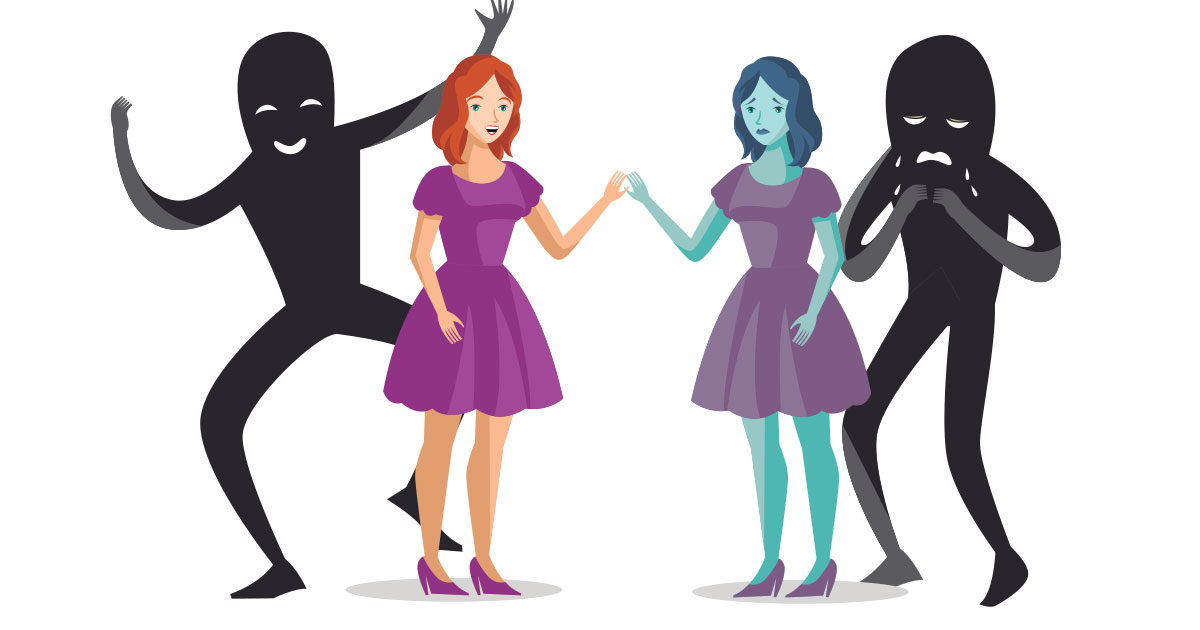Bipolar disorder is a complex mental health condition that affects millions of people worldwide. Understanding the symptoms and types of bipolar disorder is crucial for an accurate diagnosis and appropriate treatment. In this article, we will explore the various aspects of bipolar disorder, including its definition, misconceptions, symptoms, types, risk factors, causes, and diagnosing methods. If you have been wondering whether you have bipolar disorder, read on to learn more.
Understanding Bipolar Disorder
Defining Bipolar Disorder
Bipolar disorder is a complex condition that affects not only mood but also cognition and behavior. It is believed to be caused by a combination of genetic, environmental, and neurochemical factors. While the exact cause is still not fully understood, researchers have made significant progress in identifying potential risk factors and developing effective treatment strategies.
One of the key features of bipolar disorder is the presence of manic episodes. During these episodes, individuals may experience a heightened sense of self-confidence and grandiosity. They may engage in impulsive and risky behaviors, such as excessive spending, substance abuse, or engaging in unprotected sexual activities. These behaviors can have serious consequences and may lead to financial, legal, or relationship problems.
On the other hand, depressive episodes in bipolar disorder are characterized by persistent feelings of sadness, hopelessness, and loss of interest in activities. Individuals may struggle with low energy levels, changes in appetite and sleep patterns, and difficulty concentrating. These symptoms can significantly impact their ability to function at work, school, or in their relationships.
Common Misconceptions About Bipolar Disorder
There are several misconceptions surrounding bipolar disorder that often lead to misunderstandings and stigma. One common misconception is that everyone with bipolar disorder experiences extreme mood swings daily.
However, the reality is that the frequency and intensity of mood episodes can vary greatly between individuals. Some individuals may experience rapid cycling, where they have frequent mood shifts within a day or week, while others may have longer periods of stability between episodes.
Additionally, another misconception is that bipolar disorder is just a case of “moodiness” or a character flaw. In truth, bipolar disorder is a medical condition that affects brain chemistry and requires professional treatment. It is not something that can be simply overcome by willpower or positive thinking. Seeking appropriate medical care, such as therapy and medication, is crucial for managing the symptoms and improving overall quality of life.
Furthermore, it is important to note that bipolar disorder is not a rare condition. It affects approximately 2.8% of the adult population in the United States alone. Despite its prevalence, there is still a significant lack of awareness and understanding surrounding bipolar disorder, leading to misconceptions and stigma.
By educating ourselves and others about the realities of bipolar disorder, we can contribute to a more compassionate and supportive society for individuals living with this condition.
Symptoms of Bipolar Disorder
Manic Episodes and Their Indicators
During manic episodes, individuals may experience an elevated mood that is unusually intense and prolonged. They often feel extremely energized, have racing thoughts, and engage in reckless behaviors.
Some common indicators of manic episodes include decreased need for sleep, increased talkativeness, inflated self-esteem, and a heightened sense of grandiosity. These symptoms must be present for at least one week to classify as a manic episode.
Manic episodes can also manifest in other ways. For example, individuals may exhibit an increased level of creativity and productivity during these episodes. They may have a burst of ideas and engage in multiple projects simultaneously. This heightened state of mind can lead to a sense of euphoria and an intensified drive to accomplish goals.
Additionally, during manic episodes, individuals may display impulsive behavior. They may make impulsive purchases, engage in risky sexual behavior, or take on excessive financial risks. These impulsive actions can have significant consequences on their personal and professional lives.
Depressive Episodes and Their Signs
On the other hand, depressive episodes are characterized by an overwhelming feeling of sadness, hopelessness, and a lack of interest in activities. Individuals may experience significant changes in appetite and sleep, feelings of guilt or worthlessness, and thoughts of death or suicide. These symptoms must be present for at least two weeks to classify as a depressive episode.
Depressive episodes can also have physical manifestations. Individuals may experience fatigue, aches, and pains throughout their body. They may have difficulty concentrating and making decisions, which can impact their daily functioning. The severity of depressive symptoms can vary from person to person, with some individuals experiencing mild symptoms while others may have severe and debilitating ones.
Furthermore, individuals in a depressive episode may withdraw from social activities and isolate themselves from others. They may have a decreased interest in hobbies or activities they once enjoyed. This withdrawal can further exacerbate feelings of loneliness and sadness.
Types of Bipolar Disorder
Bipolar I Disorder
Bipolar I disorder is the most severe form of bipolar disorder. Individuals with this subtype experience manic episodes that last for at least seven days or are severe enough to require hospitalization. In some cases, depressive episodes may accompany manic episodes as well.
Bipolar II Disorder
Bipolar II disorder is characterized by recurrent depressive episodes and less severe hypomanic episodes. Hypomania is a milder form of mania and typically does not require hospitalization. Individuals with bipolar II disorder may go undiagnosed for some time as their symptoms may be mistaken for other mood disorders or depression.
Cyclothymic Disorder
Cyclothymic disorder is a milder form of bipolar disorder. Individuals with cyclothymic disorder experience numerous periods of hypomania and depressive symptoms that do not meet the full diagnostic criteria for manic or major depressive episodes. These mood swings are often less severe but can still significantly impact daily functioning.
Risk Factors and Causes
Genetic Factors
Bipolar disorder has a strong genetic component. Individuals with a family history of bipolar disorder are at a higher risk of developing the condition themselves. However, having a family history does not necessarily mean a person will develop bipolar disorder, as other factors can influence its onset.
Environmental Triggers
Stressful life events, such as the loss of a loved one or major life changes, can trigger the onset of bipolar disorder in susceptible individuals. Substance abuse, including alcohol and drug use, is also considered a significant environmental factor that can contribute to the development or worsening of bipolar disorder symptoms.
Diagnosing Bipolar Disorder
Medical Evaluation and Tests
When determining whether an individual has bipolar disorder, medical professionals typically start with a thorough medical evaluation. This evaluation helps rule out other medical conditions that could be causing the symptoms. Blood tests and brain imaging scans, such as MRI or CT scans, may also be conducted to further assess the individual’s overall health.
Psychological Evaluation
A psychological evaluation, conducted by a mental health professional, is essential for diagnosing bipolar disorder. The evaluation may involve interviews, questionnaires, and psychological assessments to assess the person’s mood, thoughts, and behavioral patterns. This evaluation helps determine if the individual meets the diagnostic criteria for bipolar disorder and aids in creating an appropriate treatment plan.
Ketamine Infusion Therapy
Ketamine infusion therapy offers an innovative perspective on addressing Borderline Personality Disorder (BPD). While ongoing research is shedding light on its potential, some studies suggest that ketamine’s rapid antidepressant effects might also extend to individuals with BPD, helping manage mood swings, impulsivity, and self-destructive behaviors. Administered under strict medical supervision, this therapy has shown promise in enhancing emotional well-being for some BPD patients. However, it’s essential to consult with a healthcare professional to consider its role within a comprehensive treatment strategy for this complex condition.
Parting Words
In conclusion, bipolar disorder is a complex mental health condition that requires professional diagnosis and treatment. If you suspect that you may have bipolar disorder, it is crucial to consult with a mental health professional who can evaluate your symptoms and provide appropriate guidance and support.
Remember, proper diagnosis and treatment can significantly improve your quality of life and help you manage the challenges associated with bipolar disorder. If you are interested in learning more about ketamine for bipolar disorder treatment in Winston-Salem, NC, contact us at Restoring Wellness Solutions and request your consultation today.






